
Confused? After you study the "5Es of Economics (below) it will begin to become more clear.
The following discussion on the 5Es of Economics was borrowed (and modified) from: Economics: The Options for Dealing with Scarcity by Frank D. Tinari, Scott, Foresman and Company, 1986. IT IS NOT FOUND IN YOUR TEXTBOOK.
Just what is the study of economics? The definition that I like best is:
Economics is the social science that studies how we choose to use limited resources to obtain the maximum satisfaction of unlimited human wants
This definition has four parts that we need to discuss:
The definition of "economics" that I used when I first began teaching was:
Economics is the study of why Mark doesn't have a boat.
( NOTE: Soon after I moved to Illinois I bought a house in Wonder Lake in McHenry County. Wonder Lake is a nice lake, but we didn't own a boat.)
This definition highlights an important component of economics: SCARCITY. The reason why I didn't have a boat, or the reason why you don't have everything that you want, is because of SCARCITY.
The term "scarcity" has a slightly different definition in an economics class than it does in the "real" world.
If the price of boats goes up, then demand for boats goes . . . . . .
NO! THE DEMAND DOES NOT GO DOWN. The quantity demanded goes down, but not demand itself BECAUSE ECONOMISTS HAVE A DIFFERENT DEFINITION FOR DEMAND. We'll talk more about that later.
Another example is the word INVESTMENT. In an economics class the term "investment" does NOT mean the stock market, money markets. or mutual funds. We will have to call such things "financial investments" because the term "investment" has a different meaning in economics.
Is is important to be aware that economic terms may have a different, and more specific, definition in a college course than they do outside of class. You, of course, need to learn this new definition.
So back to the term SCARCITY. Scarcity does not mean that only a little of something is available. For example, I grew up in northeastern Minnesota . About 30 miles away from my hometown was the town of Erskine, Minnesota. Just outside of town a certain type of rock exists that occurs nowhere else in the world. They have named it "Erskinite". Erskinite is only found near Erskine, Minnesota, and only a little of it has ever been found. BUT IT IS NOT SCARCE. -- WHY? - -
Erskinite is not scarce because nobody wants it. For there to be scarcity things must be LIMITED and WANTED. There is plenty of ERSKINITE (even though there is only a little) and it IS NOT SCARCE because nobody wants it.

Goods and services are scarce. These are the things that we want. Goods are tangible things that satisfy our wants (like boats, computers, cars, skis, etc.), services are intangible things that satisfy our wants (like the services of an accountant, or a dentist, or a lawyer, or a ski resort). Even in the United States - one of the richest countries in the world - goods and services are scarce. WHY?
This brings us to another important principle in economics.
After teaching economics for a year or so, I bought a boat. Since I defined economics as the study of why I didn't have a boat - I had a problem. But then I simply changed my definition slightly. Now economics is: the study of why Mark doesn't have a . . a . . .a what?
This brings us to that second principle: economists assume that humans have UNLIMITED WANTS. Once I got a boat, I wanted a bigger boat. After getting a bigger boat I wanted a sailboat. then a row boat, and . . . and the list goes on and on. (I used to own 5 boats and I wanted a jetski.) Do we ever have EVERYTHING that we could ever want?
Since human wants are unlimited, and resources used to satisfy those wants are limited - there is scarcity. Even in the US, one of the richest countries in the world, there is scarcity -- if we use our new definition of SCARCITY. Do you have everything that you want? There is always scarcity, because human wants are unlimited.
This then brings use to a third important idea: Because of scarcity we MUST MAKE CHOICES. Some economists call this the "economizing problem". We can't have everything that we want so we have to choose.

The authors of our textbook define economics as: "The social science concerned with how individuals, institutions, and society make optimal (best) decisions under conditions of scarcity"
This is what microeconomics is really all about - MAKING CHOICES. Because of scarcity we as individuals, and our society as a whole, must make choices. For example when I was thinking about buying a boat, I also needed shoes for my daughter. If we assume that I couldn't afford both (again - can you afford everything that you want?) I had a choice to make a boat or shoes?
Hm-m-m-m-m? ? ? - - - - - I bought a nice boat!
It is important to note that our GOAL is to make choices that reduce scarcity as much as we can. Because of unlimited wants we can never eliminate scarcity, but it can be reduced by the right choices.
Another way to say this is that we want SOCIETY to get the MAXIMUM SATISFACTION POSSIBLE out of our limited resources. We don't want to make just any choice, we want to make the BEST (or optimal) choice.
There are three, and only three, options (choices) for society to deal with scarcity, and all societies must deal with scarcity because there are limited resources and unlimited wants.
Those three options are:
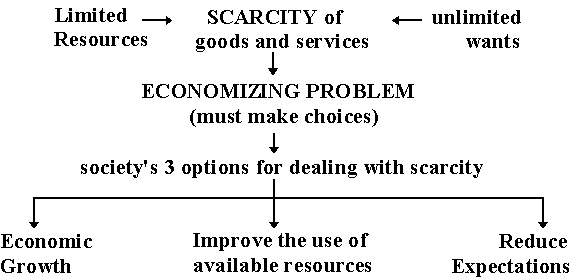
There are four ways to improve the use of available resources. They are:
The 5Es of Economics, or the five ways for society to reduce scarcity, then are:
A 6th "E" of economics might be Reducing Expectations, but economists do not spend much time discussing this option for dealing with scarcity. One way for a society to handle scarcity is to reduce its wants. If we just didn't want so much then there would be less scarcity. For example we know that gasoline is scarce. (Can you get all that you want for the price you want? If you have to pay a price for something, then it is scarce.) Space on our roads is also often very scarce. Let's say that the president of the United States decides to do something about these problems by initiating a new program called: SHARE A CAR WITH YOUR NEIGHBOR. It includes a law that says there can only be ONE CAR FOR EVERY TWO FAMILIES. This would reduce the scarcity of gasoline and space on our roadways, but . . . . let's impeach that president!!!
The option of REDUCING WANTS is one of the options that societies have for dealing with scarcity, but it is not a very good option. Maybe during war time, if our president asks us to "share a car with our neighbor", we would. But it is not a long-term solution to the problem of scarcity that most of us would accept. Although it is an option that we should keep in mind. some groups do handle scarcity this way. Catholic nuns, the Amish, the hippies of the 1960s all reduce their wants of goods and services.
The figure below summarizes the concept of scarcity, the necessity of making choices, the three options that society has for dealing with scarcity, and the 5Es of Economics.
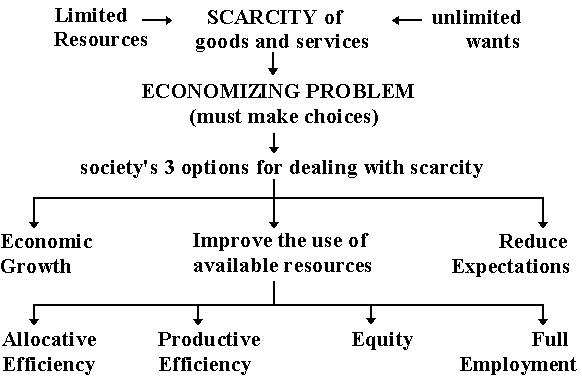
Let's now look at each of the five ways that society has for dealing with scarcity - the 5 Es.
One option for dealing with scarcity and the the first "E" of economics is Economic Growth.
We define Economic Growth as an increase in the ABILITY to produce goods and services. Note that this is not the way the term is normally defined. The news media would define economic growth as occurring when a country produces more in one year than they did in the previous year. This is not how we define economic growth here. Later this semester we'll discuss the other definitions of Economic Growth, but here we'll use this more fundamental definition.
Economic Growth is an increase in the ABILITY to produce goods and services. [MEMORIZE THIS!]
This type of Economic Growth is caused by a society getting:
a) more resources,
b) better resources, or
c) inventing better technology.
How does economic growth reduce scarcity and increase society's satisfaction? If we only had more resources we could produce more goods and services and satisfy more of our wants. This will reduce scarcity and give us more satisfaction (more good and services). All societies therefore try to achieve economic growth. (Note: This means we are ABLE to produce more, but it doesn't necessarily mean we do produce more. More on this later.)
An example of how this more fundamental type of ecomomic growth increases society's satisfaction would include the discovery of more resources, like the discovery of a huge reserve of crude oil under Harper's campus. With this discovery the economy would be ABLE to produce more gasoline. Having more gasoline would reduce scarcity and increase society's satisfaction. Another way economic growth increases society's satisfaction would be getting better resources. Students go to college to improve their skills. With these improved skills (better resources) graduates will help the economy produce more for society. Finally, inventing new technology makes the economy ABLE to produce more and therefore increases society's satisfaction. Here we are talking about the technology of production, the technology in the factory. For example, in the past few decades new GPS (golobal positioning system) technology has enabled farmers to grow more on the same amount of land. "More" is good because it helps society reduce scarcity and therefore increase our satisfaction.
Societies can reduce scarcity not just by (1) getting more resources, better resources, or better technology (i.e. ECONOMIC GROWTH), or by (2) REDUCING ITS WANTS, but also by (3) IMPROVING THE USE OF AVAILABLE RESOURCES (use existing resources wisely).
There are four ways that societies can use their EXISTING resources to reduce scarcity. We could call these the 4 Es of economics - four ways to use our EXISTING resources to reduce scarcity and obtain the maximum satisfaction possible. The fifth E (economic growth) also reduces scarcity and gives us more satisfaction but it does it by using ADDITIONAL resources. Societies will try to achieve all 5 Es of economics.
The four ways that societies can use their EXISTING resources (improve the use of available resources) to reduce scarcity are:
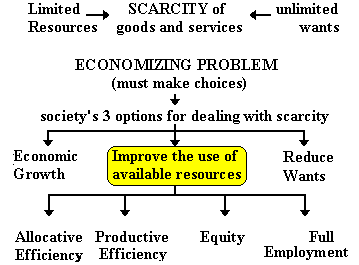
Let's discuss each of these individually keeping in mind
This is harder than you think. Many students have a hard time learning a different definition for a term that they thought they already knew, and many students lose sight of the GOAL of economics: to reduce scarcity and help society achieve the maximum satisfaction possible.
Productive efficiency can be defined as, or achieved by, producing at a minimum cost.
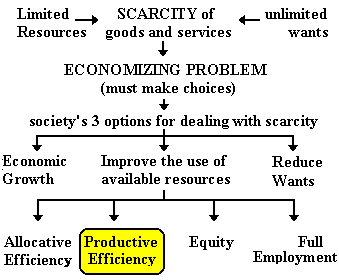
By producing at a minimum cost, FEWER RESOURCES are used and MORE can be produced. This reduces scarcity and gives us more satisfaction from our existing resources. [MEMORIZE THIS!]
We can produce at a minimum cost and achieve productive efficiency by:
a. not using more resources than necessary
b. using resources where they are best suited
c. using appropriate technology
Let's look at each of these individually using some examples. REMEMBER our goal is to understand how they reduce scarcity and help society achieve the maximum satisfaction possible from its existing resources. This is the goal of economics. You must keep this goal in mind as we go through these examples.
not using more resources than necessary
How does this MAXIMIZE SOCIETY'S SATISFACTION?If businesses use extra resources that they do not need, then these resources are wasted. Since we know that resources are limited and human wants are unlimited, let's not waste any of the few resources that we do have. By not using more resources than necessary, we free up resources that can be used somewhere else and we PRODUCE MORE.
Examples:
(a) Janitors at HarperLet's assume that Harper College employs 50 janitors to clean its buildings and that's enough to do a good job. If Harper then hired 25 more janitors this would be wasteful. Even though they could probably find something to do to keep busy, they aren't needed. Fifty janitors can do the job. So society would be better off if Harper did NOT employ these 25 additional janitors so that they could go get a job somewhere else (like maybe at a boat factory) where they would produce more for society. It would be productively inefficient to employ 75 janitors at Harper. Harper's costs will be higher (productive inefficiency) and society's output would be lower (less boats = less satisfaction = more scarcity).
(b) Grocery stores: USSR
Several years ago, one of my students gave me this example. She had visited Moscow when the communist Soviet Union still existed. She said that she was surprised when she entered a grocery store and saw four employees at every cash register! What a waste of labor resources. In the US we find one, or two, workers at a checkout stand and only a few will be open. In Moscow ALL stands were open with four employees each. This is productively inefficient. Their costs are higher and since labor is being wasted, they will produce less. Some of these workers could be working elsewhere producing more. They are not achieving the maximum satisfaction possible from their limited resources (productive inefficiency).
(c) Coca-Cola/Motorola/Sears/AT&T/etc. lay off 1,000s of workers
Take a brief look at one or a few of the following news articles.
- Coca-Cola Lays off 6000
http://www2.harpercollege.edu/mhealy/eco211/lectures/day1/coke.html
In the year 2000 , Coca-Cola laid off over a fifth of its workforce. If we can assume that Coke laid off these workers and was still able to produce the same quantity of Coke then they were employing more resources than necessary and were not producing at a minimum cost. They were productively inefficient.
Often, but not always, when you hear about massive layoffs in the news media, this is GOOD NEWS. It means that companies were able to produce products using fewer resources (lower costs) and this "frees up" labor that is then available to work else producing MORE for society. If Coke is still producing the same as they were before, and if these 6000 layed off workers get jobs at a boat factory, then we will have the same amount of coke and MORE BOATS. More boats will increase society's satisfaction from our available resources.
- Layoffs Rise in November (1999)
https://money.cnn.com/1999/12/07/companies/layoffs/Record job-cutting, but the economy still had full employment
Why are these layoffs good for society?
If each company was able to continue producing the same amount of output after laying off thousands of workers then they must have been productively inefficient before the layoffs. So, if it would be good for Harper to only employ 50 janitors (and layoff the extra 25) or if it would be good for the grocery stores in the Soviet Union to lay off some of their employees, THEN THESE LAYOFFS ARE GOOD FOR SOCIETY BECAUSE MORE WILL BE PRODUCED WHEN THESE LAYED OFF WORKERS GET JOBS ELSEWHERE.
I realize that this may be a bit controversial. If you have questions let's discuss them on our discussion board or in class.
Keep in mind the GOAL: reducing scarcity and achieving the maximum satisfaction possible from our limited resources. If these companies can still produce the same amount of output with thousands fewer employees, by laying them off they become available to work somewhere else producing MORE for society.
WHAT IF THEY DON'T FIND ANOTHER JOB? Would it be better for society to have them stay at companies where they are not needed or to be unemployed?
I would consider the possibility that it would it be BETTER for society to have them be unemployed. That way we know they are AVAILABLE for any new boat companies that may want to build a new factory. Let's assume that the Coca-Cola company has 6000 workers in Atlanta that they do not need (productive inefficiency) This means if they laid off these 6000 workers they could still produce the same quantity of Coke. It would be a shame if a boat company wanted to build a brand new factory near Atlanta, Georgia, but then after investigating the labor market there they decide not to build the factory because there were not enough workers available because they were all working at Coca-Cola
Note: not all layoffs are good for society.
WHY ARE THERE LAYOFFS?
- If there is productive inefficiency
- Improved Productive efficiency allows business to produce the SAME AMOUNT OF OUTPUT with fewer workers
- These layoffs are GOOD for society because they reduce scarcity (more products are produced)
- If there is allocative inefficiency
- Allocative efficiency means the economy uses its limited resources to produce what people want
- Resources are not wasted producing products that people do not want
- Some layoffs occur in industries that were producing products that people no longer wanted
- These layoffs are GOOD for society because they reduce scarcity (more products are produced)
- If there is a recession
- Some layoffs are the result of an economic recession when unemployment rises and people buy fewer products
- These layoffs are NOT GOOD for society because they result in MORE SCARCITY (fewer products are produced)
using resources where they are best suited
The second way to produce at a minimum cost and achieve productive efficiency is to use resources where they are best suited.How does this INCREASE SOCIETY'S SATISFACTION?
If businesses use resources where they are best suited then MORE can be produced from the same amount of resources.
Examples:
(a) secretaries / truck driversLet's say I own a company which employs secretaries and truck drivers. Normally the secretaries type letters and the truck drivers drive trucks. One day I decide to try something new . I had the secretaries drive the trucks and the truck drivers type letters.
What happened to the COST per load delivered or the COST per letter typed? Hopefully you were thinking "they went up". Therefore we are not producing at a minimum cost and we are productively inefficient. Furthermore, and most importantly, LESS WILL BE PRODUCED - fewer letters will be typed and fewer loads will be delivered.
Therefore, to be productively efficient and achieve the maximum satisfaction possible from our existing resources we must use resources where they are best suited.
(b) doctors/engineers
Doctors should work in the hospitals and engineers should build the bridges. This would be productively efficient. More bridges will be built and more lives saved . It would be productively inefficient (i.e. more costly) to have engineers work in the hospitals and doctors build the bridges. Fewer bridges would be built and fewer lives saved. This would be productively inefficient - a waste of existing resources.
(c) Illinois-corn/Alabama-cotton - another example, but with something new
Illinois has resources (weather, machinery, soil, etc.) better suited to grow corn, whereas Alabama has resources better suited to grow cotton. So it makes sense for Illinois to grow corn and for Alabama to grow cotton since this way we get more corn and more cotton from the same amount of resources. This is productively efficient. But there is just one problem. In Illinois we have a lot to eat (corn) but no clothes (cotton). And in Alabama they have cotton clothing, but they are starving. So what do we do?
We exchange or trade. Illinois sells corn to those in Alabama and they sell cotton to Illinois.
If we didn't trade then Illinois would have to grow both corn and cotton and Alabama would have do the same. The result would be LESS CORN and LESS COTTON being produced. From the same resources we would have fewer goods because we are not using resources where they are best suited - i.e. productive inefficiency.
(d) North Dakota-potatoes / Honduras-sugar
North Dakota has resources suited to growing potatoes (cold climate, good soil, etc.). Honduras, in Central America, has resources suited to growing sugar, or sugar cane (hot wet climate, poorer soils, etc.). So it is productively efficient to grow potatoes in North Dakota and to grow sugar in Honduras. Costs are lower, and more importantly, more can be grown with the existing resources. This helps society get the maximum satisfaction possible from its existing resources.
Why, then, do they grow sugar (sugar beets) in North Dakota? The sugar that we get from sugar beets is very expensive. Why do we grow sugar beets in North Dakota when we can get cheap, high quality, sugar from Honduras?
The answer has to do with trade. There is free trade between Illinois and Alabama. Free trade means that the government does not try to restrict trade with taxes or other barriers. Therefore, Alabama and Illinois can use their resources where they are best suited and achieve productive efficiency, i.e. they produce more with the resources available.
But there are trade restrictions on sugar between the US and Honduras. This, then, encourages the farmers to be productively inefficient. The barriers to free trade results in higher prices and this encourages North Dakota farmers to grow sugar resulting in productive inefficiency and LESS BEING PRODUCED.
(e) free trade
Free trade, then, is a necessary condition to achieve productive efficiency since it allows resources to be used where they are best suited - regardless of the state, or the country. [REMEMBER THIS: free trade helps achieve productive efficiency by allowing companies/countries to use resources where they are best suited.]
(f) discrimination
Economists have a slightly different view of discrimination than you are probably used to. Economists would ask, "How does discrimination affect the quantity of boats (and everything else) that are produced with the resources available?" Since discrimination is by definition NOT USING RESOURCES WHERE THEY ARE BEST SUITED, it results in higher costs and less output - or productive inefficiency.
using appropriate technology
The third way to produce at a minimum cost and achieve productive efficiency is to use the appropriate technology. By "appropriate" we mean the technology that minimizes the costs. Sometimes this is termed the "best "technology. But I prefer "appropriate" because "best" may infer "high tech" or computer technology. But the most up-to-date technology is not always the most appropriate (lowest cost).How does this INCREASE SOCIETY'S SATISFACTION?
By using the technology that minimizes costs, it minimizes the amount of resources used, since it is the resources that make up the costs of production.
Examples:
(a) farming: US / KenyaFor example, in the US farmers use tractors to plow their fields, whereas in the country of Kenya (in East Africa) many field are plowed by hand. It could be argued that both farmers ARE being productively efficient. The cheapest way to plow in the US is my using a $100,000 tractor. In Kenya, tractors, fuel, repairs, etc., are very expensive and labor is relatively inexpensive, so it makes economic sense to plow by hand.
(b) farming: tractors / helicopter
Why don't US farmers use "modern" technology and plow their fields with helicopters and laser beams (sort of like the Jetsons)? The answer is easy, it would be too costly. There are cheaper, and more productively efficient, ways to get the job done.
The second way to use our existing resources to increase society's satisfaction is allocative efficiency.
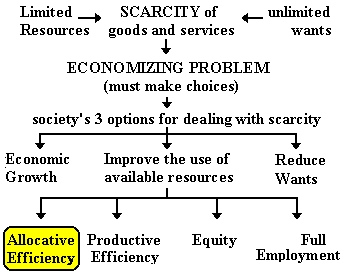
Allocative efficiency is using our limited resources to produce the right mix, or amounts, of the various goods and services - not too much, not too little, but the amount that gives society the most satisfaction. This means it is allocatively efficient to produce more of what people want and less of what they don't want.
How does this INCREASE SOCIETY'S SATISFACTION and REDUCE SCARCITY?
The answer to this question is obvious. If we want to achieve the maximum satisfaction possible from our limited resources, we not only have to be productively efficient (use as few resources as possible, use our resources where they are best suited, and use the appropriate technology), BUT WE ALSO HAVE TO PRODUCE THE RIGHT GOODS AND SERVICES. It would be a waste of our limited resources to produce a lot of things that we don't want and few of the things that we do want.
For example:
a. steel: horseshoes or cars. It would be a waste of our limited supply of steel to produce billions of horseshoes that nobody wants and only a few cars that people do want. This would be allocatively inefficient.b. crude oil: gasoline or kerosene. People want more gasoline and very little kerosene. Therefore to use our resources wisely, we should use our crude oil to produce more gasoline and less kerosene because society will get more satisfaction from more gasoline than from more kerosene.
c. small cars or SUVs. As onsumer tastes move away from small cars to large Sport Utility Vehicles, an allocatively efficient society would use its resources to produce more SUVs and fewer small cars. Car companies lay off workers in their small car factoies and are expanding their SUV factories. This helps society achieve allocative efficiency and increase the satisfaction that society gets from its (labor) resources. because people want more SUVs.
Whenever we produce too much (surplus) or too little (shortage) we are allocatively INefficient. We are NOT using our resources in a way that would achieve the maximum satisfaction possible.
Examples of allocative inefficiency:
(1) US agriculture producing mountains of unwanted grainUS (and European) farmers used to produce mountains of grain that they couldn't sell. WHY? Pizza Hut doesn't produce piles of pizzas that they cannot sell. Homebuilders do not build hundreds of homes that they cannot sell. Why did US farmers grow more grain than they knew they could sell?The answer is - the government. The US government would buy the surplus grain from the farmers. This encouraged them to plant even more. The allocative inefficiency here is not the mountains of grain that nobody wanted, but rather the loss of the resources farmers used to grow that grain. Labor, land, energy, chemicals, machinery, etc. were wasted producing something that society didn't want. The real loss for society are the products that we COULD HAVE HAD if farmers hadn't used so many resources producing excess grain. This is allocative inefficiency and it reduces the satisfaction that society receives from its resources. (NOTE: recent changes in government policy have reduced the amount of excess grain being produced.)
(2) Long lines in Poland and other communist countries
Prior to 1989 when communism in Eastern Europe collapsed, Poland and other countries had severe shortages of consumer products resulting in long lines (queues). This is a good example of allocative inefficiency. Severe shortages reduce society's satisfaction.(3) Super Bowl tickets
There is a shortage of Super Bowl tickets. Hundreds of thousands of fans want to attend the game but only about 80,000 seats are available. This is allocative inefficiency. WHAT CAN BE DONE?Build a bigger stadium? Play a 2 out of 3 (or 4 out of 7) series? OR - why not simply raise the price? The price of a regular Super Bowl ticket is around $500. At this low price, hundreds of thousands of people want to go. But what if the price was raised to $1000 or $2000, or to whatever price will result in only 80,000 tickets being sold. If they raised the price, there will be no shortage. SHORTAGES ARE CAUSED BY A PRICE THAT IS TOO LOW. This results in allocative inefficiency and less satisfaction for society.
Prices are very important. Allocative inefficiency is usually caused by the price being too high (creating a surplus) or too low (creating a shortage).
(4) Natural disasters and "price-gouging"
Let's try another example to illustrate the importance of getting the price right to achieve allocative efficiency. After hurricane Georges struck Florida in 1998 the price of plywood, water, hotel rooms, and many other things increased dramatically. Were these price increases GOOD for the people living in Florida?
YES!!!!
This may seem controversial to many of you, but let me explain and I think you will agree with me. Why it is GOOD for the people of Florida if, after a hurricane strikes, the price of plywood (or other products) increases from $10 a sheet to $30 a sheet
[See: http://www.csmonitor.com/1992/0910/10083.html ]After Hurricane Georges, the people of Florida did not have all the plywood that they wanted, This is allocative inefficiency (shortage). To help them we would want two things to occur:
(1) more plywood should be shipped to Florida, and2) the people of Florida should try to conserve the plywood that they do have.
These two things would be good for the people in Florida.
Let's say that the price of plywood increased from $10 a sheet to $30 a sheet. WHAT HAPPENS BECAUSE OF THIS PRICE INCREASE?
Well, people standing in line to buy plywood to fix their walls, their decks, and their doghouses, will buy less and maybe decide to only fix their walls now, i.e. they conserve. This is good for the people of Florida.
ALSO, maybe somebody sitting in the back of their pickup truck on a Friday night in Chicago will hear a news report on the high price of plywood in Florida. And they may start to calculate: 100 sheets that would fit in the back of the pickup would cost, in Chicago, $1000 (100 sheets times $10 a sheet). If they drove to Florida they could sell the sheets for $3000 (100 sheets times $30 a sheet). This is a profit of $2000 in one weekend! Trucks full of plywood would be heading for Florida from all parts of the country! This is good for the people in Florida.
Now, let's say that the government of Florida wants to "help" its citizens by preventing this "price-gouging" or these higher prices that occur after a natural disaster. So they pass a law making price-gouging illegal. Let's assume that if you sell plywood for more than $10 a sheet you will be arrested. (See links below.) WHAT IS GOING TO HAPPEN? Does this Law help the people in Florida who need plywood?
First, if the people in all those pickup trucks full of plywood hear of this anti-price-gouging law, they will turn around and drive home. This is bad for the people of Florida.
Also, those people standing at the front of the lines at the lumber yards, seeing that the price is still only $10 a sheet, will buy extra to repair their decks and fix their doghouses. This is bad for the people of Florida.
The result of the anti-price-gouging law is a SHORTAGE. A shortage CREATED by the law, not by the hurricane.
When the price of plywood rises to $30 a sheet after a hurricane it is allocatively efficient and GOOD for the people of Florida. They will CONSERVE the plywood that they have and MORE will be shipped in. This is good. Do you agree?
Oftentimes students say, "what about the poor people who can't afford the higher prices?" Will the anti-price-gouging laws help them? Will a low price for plywood help them?
NO, because there will be a shortage. This means NO PLYWOOD is available for anyone (unless they just happen to be at the front of the line).
- See: http://www.atlassociety.org/how-price-gouging-laws-make-hurricanes-worse
- See: http://mises.org/daily/1593/ (Price Gouging Saves Lives)
There are better ways to help the poor. This is especially true if we can agree that the laws keeping the prices down actually hurt the poor by creating a shortage. The government could give the poor money, or haul in more plywood - but a law that keeps prices low hurts all except the few at the head of the line.
I realize that this may be a bit controversial. If you have questions let's discuss them on our Blackboard Discussion Board.
Article on "price-gouging" in Florida: http://www.nytimes.com/2004/08/18/national/18scams.html
(5) food price controls
The government-created low prices in Florida after a hurricane CREATED A SHORTAGE. What if a government keeps food prices too low? What do you call a shortage of food? -- FAMINE or STARVATION! Millions of people have been starved to death by governments that have lowered food prices creating famines. The purpose of keeping food prices low was to help the poor and the hungry. The effects of keeping food prices low is famine. Two things happen when governments lower food prices: (1) farmers make less money so they work less and grow less, and (2) since prices are low those who do find food buy more. The result is a shortage.(6) gasoline
Different government policies concerning gasoline prices have had different effects.(a) W.W.II
During World War II, the US government kept the price of gasoline down. This created a shortage. To handle the shortage they had to issue ration coupons. If you wanted to buy gas, you first needed a coupon. The government created the shortage. The government created allocative inefficiency.
(b) 1970s: Arab oil embargo
In the 1970s, Israel attacked its Arab neighbors and the US supported Israel. In response, the Arab oil producers refused to sell oil to the US. This would have caused the price of gasoline to increase greatly, but President Nixon prevented the price from rising. This created a shortage. Gas stations had long lines (queues). Some would only sell gasoline on certain days or limit a purchase to 5 gallons. The government created the shortage. The government created allocative inefficiency.
(c) during the Gulf Wars / Iraq war
In the early 1990's the government of Iraq invaded the country of Kuwait disrupting oil exports from the Persian Gulf. But there was NO shortage of gasoline! If you wanted to buy gas you just had to drive to a gas station and fill 'er up. Why wasn't there a shortage of gasoline this time? Because the government allowed the market to work and the price increased. As a result two things happened: (1) gasoline producers did all they could to produce more gasoline because they were making a lot of money, and (2) drivers conserved, carpooled, bought smaller cars, and drove less. Hence, NO SHORTAGE. This was allocatively efficient and good for society.
WHAT CAN BE DONE to achieve allocative efficiency?
In a market economy, or pure capitalism (we will study this in lesson 2a), the price will adjust to achieve allocative efficiency (we will study this in lessons 3a, 3b, and 3c). Very little "has to be done".
Inefficiency occurs when :
Prices are very important. Allocative inefficiency is usually caused by the price being too high (creating a surplus) or too low (creating a shortage). In lessons 3a, 3b, and 3c we will study how a market economy results in prices that usually achieve allocative efficiency. In lesson 5a we will study how the government sometimes interferes with prices and causes allocative inefficiency. This means that the government causes more scarcity and reduces society's satisfaction. Also in clessons 5a and 5b we will study examples of when the market does NOT get the price right and then the government may interfere, changing product prices, in order to achieve allocative efficiency and increase society's satisfaction.
To achieve allocative efficiency in a market economy like that of the United States, the price has to be "right".
Why is the price of gasoline in the United States TOO LOW? Don't be surprised, many people believe gasoline prices are too low. In lesson 5a we will study why many countries in the world have large taxes on gasoline. For now you should be thinking that maybe the market for gasoline in the United States is allocatively inefficient because the price is too low; therefore we consume too much (allocative inefficiency); and possibly it would be good if we raised our gasoline taxes to be more like most other countries.
I realize that this may be a bit controversial. If you have questions let's discuss them on our Blackboard Discussion Board or in class. All I want to say now is to ask "WHY are gasoline prices so much higher in Europe than in the US? (See: http://money.cnn.com/2011/03/10/news/international/gas_prices_worldwide/index.htm ) Think about it. They buy their gasoline from the same companies as we do. They are closer to the Middle East, the source of much of the oil used to produce gasoline. So you would think that their prices would be the same as ours. What causes the difference?
Students usually say things like:
But, if these are true then they are the RESULT of high gasoline prices, not the CAUSE of them. They have better public transportation, drive smaller cars, and drive less BECAUSE gasoline prices are high -- BUT WHY ARE THEY SO HIGH IN THE FIRST PLACE?
The correct answer is TAXES. In Europe they have a much higher tax on a gallon of gasoline - a TAX of $4.00 per gallon or more! Voters in these countries have elected and reelected officials who support high gasoline taxes. Basically, what the voters have said is "gasoline prices are too low and we want the government to raise them". So the question "Why is the price of gasoline in the United States TOO LOW ?" may not that crazy. We will discuss this more in lesson 5a.
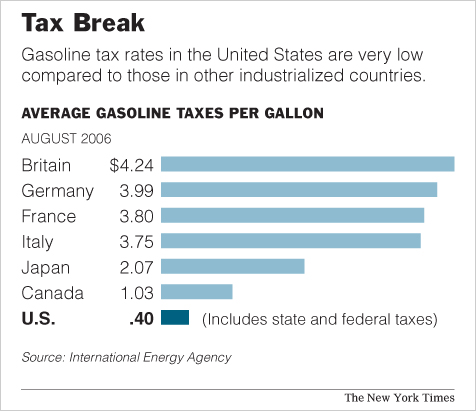
From: http://gregmankiw.blogspot.com/2006/10/gasoline-taxes-around-world.html
Also see: [http://www.statista.com/statistics/221368/gas-prices-around-the-world/]
The third way to use our existing resources to achieve the maximum satisfaction possible is equity.
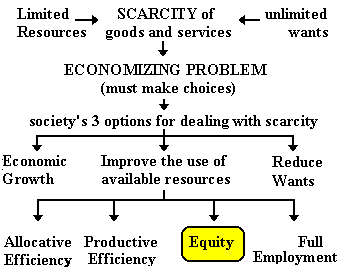
DEFINITION: Equity is a "fair" distribution of income, or goods and services. (NOTE: this is not the same definition used by accountants.) One problem with this definition is agreeing on what "fair" means.
Fair does not mean "equal". Would an equal distribution of income be good for society? Would it be good if doctors were paid the same as janitors? Probably not. If we paid doctors the same as janitors we would have few doctors, and they would not put in the time needed to learn medicine.
We know that equity is good for society (it is one of the five Es). So equitable cannot mean the same as equal. But we can't measure "fairness". This is a problem for economists. But we can DESCRIBE the actual distribution of income but we can't say if it is "fair". After describing the actual distribution of income I will also try to explain how equity does help society achieve the maximum satisfaction possible from its limited resources.
The Distribution of Income.
When economists describe the distribution of income they usually divide the population into groups of equal sizes (usually five called quintiles) according to their income levels. In the first quintile the put the poorest fifth (20%) of the population. In the fifth quintile they put the richest twenty percent, and they divide the remainder into the other three groups according to their incomes.
For data on the distribution of income in the US see: http://www.harpercollege.edu/mhealy/eco211/lectures/intro/incomedistrib.htm
For data on the distribution of income in the world see: http://www.globalpolicy.org/component/content/article/218/46595.html
For 2007 the US distribution of income was:
|
|
|
|
|
|
|
|
|
|
|
|
|
|
Comments (discussion borum) ?
How does equity help society achieve the maximum possible satisfaction from its limited resources?
How does equity increase society's satisfaction from its limited resources? This is a very difficult concept for many students to understand. Please read this "President Trump Example carefully.
President Trump Example
Since it is difficult for us to agree on a definition of "fairness", let me see if I can come up with an extreme example on which we can all agree. What if President Trump owned everything? I mean EVERYTHING - all the land, all the buildings, all the food, all the clothes all the cars, -- everything in the country. Therefore, the rest of us own nothing. We are homeless, starving, and naked. Not a pretty picture, but can we all agree that this is not fair (not equitable)?Now, let's say that President Trump gives us each a pair of pants. We should be able to agree that this is more fair, more equitable, right? So what happens to society's satisfaction? when we go from unfair to more fair? By "society" I mean all of us including President Trump. We who received the pants are more satisfied since each of us has a pair of pants, but President Trump is less satisfied because he has 300 million fewer pairs of pants.
So what happens to society's (us and Trump) TOTAL satisfaction? It depends on HOW MUCH happier we are and HOW MUCH less happy President Trump is. This brings us to the Law of Diminishing Marginal Utility (you may want to look this up in the index of your textbook).
Utility is the reason we consume a good or service. You might call it the satisfaction that we get when we consume something. I get satisfaction (utility) when I drive my boat. I get utility (satisfaction?) when I go to the dentist.
"Marginal" means EXTRA or ADDITIONAL. So if I drive my boat a second time I get some additional (marginal) utility.
According to the law of diminishing marginal utility the EXTRA (not the total) utility diminishes for each additional unit consumed. The first time I drive my boat in the spring I really enjoy it. But after a few weekends of boating it doesn't give me as much additional satisfaction as the first time. I still go boating. My total utility still goes up. But the MARGINAL (extra) utility I get from one more day goes down.
Back to the President Trump Example. Since we start with no pants, the first pair we get from President Trump gives us A LOT of utility (satisfaction). But, since President Trump still has millions (or billions) of pairs of pants left, giving us 300 million causes his utility (satisfaction) to go down only A LITTLE. OVERALL the society's utility (all of us including President Trump ) increases.
From the same amount of pants, when we go from unfair to more fair, society (including Trump), receives more satisfaction because we gained more satisfaction from our first pair of pants than Trump lost by giving away 300 million (because he still has billions). So a more fair distribution increases society's total satisfaction.
The last E is full Employment.
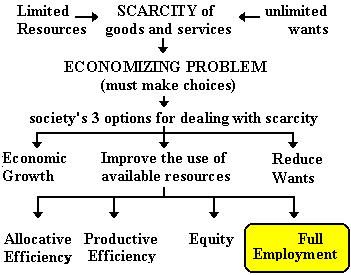
Many students have a peoblem understanding how full employment increases society's satisfaction because we have a different definition of full employment than the definition that is used most often.
DEFINITION: Here we will define full employment as using ALL available resources, not just labor. This means that if we have full employment we are using all of our labor, factories, mines, fields, tool, etc. If you read about unemployment in the news they will discuss only unemployed labor, but we will discuss unemployed fctories and unemployed fields.
How does full employment (of ALL available resources) increase society's satisfaction? How does full employment reduce the scarcity of goods and services?
If we have full employment, if we use ALL of our available resources, we produce MORE. If we have unemployed resources, we produce LESS. This is why society's strive for full employment - it reduces scarcity and helps achieve the maximum satisfaction possible because with full employment MORE is produced. Unemployed field do not produce crops. If we use all of our available fields then more crops will be produced and this will increase society's satisfaction.
FROM THE AUTHORS OF OUR TEXTBOOK:
The concept of "full employment" is potentially problematic, particularly for those courses that will eventually cover macroeconomics. The use of the term in this chapter refers to the use of all available resources, human and non-human. In macroeconomics the concept is used to describe general conditions in labor markets and the economy as a whole, but is usually focused on the economy's use of its human resources. Even then it is recognized that under conditions of full employment there is unemployed labor. There is also the potential for confusion as the concept applies to the land resource. Fully employed deposits of coal or petroleum do not imply exhaustion of those resources. It is more a question of whether there is an adequate amount of these non-human resources available to sustain full employment in labor markets. A full discussion of this is probably not appropriate with students at this point, but you may find it useful to emphasize here that the concept is most often applied to the human resources. Then, when the topic arises again in [macroeconomics], students will be less likely to feel that you are changing definitions on them.
